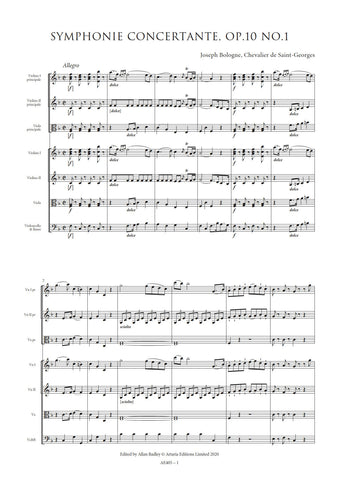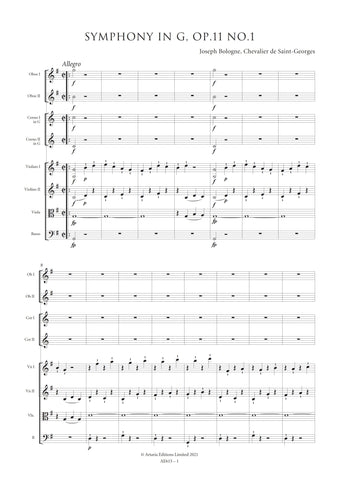Saint-Georges, Joseph Bologne de: Three Sonatas for Violin & Fortepiano Op.1(b) (AE430) – sheet music
Previous Product Next Product
Description |
Saint-Georges, Joseph Bologne de (1745-1799)
For ABRSM exam students: This edition contains the Allegro (1st movt from Sonata No. 3 in G Minor Ob. 1b) as listed on the ABRSM syllabus for Violin Grade 7 from 2024. |
||||||||||||||||
Details |
By the standards of the period Saint-Georges was not a prolific composer but this is perhaps hardly surprising given the exceptional range of his activities. The majority of his instrumental works were published in Paris between 1772-1779 and include string quartets, violin concertos and symphonies concertantes. The Three Sonatas for Fortepiano & Violin were published by Le Duc in 1781 as 'Ier OEuvre de Clavecin': TROIS SONATES / Pour le Clavecin Ou Fort Piano / avec accompagnement de Violon Oblig/ Composes Par / MR DE ST GEORGE / ier OEuvre de Clavecin / Prix 6ll / A PARIS / Chez Mr Le Duc rue Traversiere St honor cd L'Hotel de Byonne / A.P.D.R. / Ecrit par Melle Ollivier. The Op.1 designation is misleading since a set of six string quartets by Saint-Georges had appeared as Op.1 under Sieber's imprint some eight years earlier. In addition to these works and the Six sonates pour le violon issued posthumously [as Op.post.1] in two sets of three by Pleyel in 1799, Saint-Georges composed at least another seven works for fortepiano and violin. Four of these are described by Guede [Alain Guede, 'Catalogue des oeuvres de Joseph [Boullogne] de Saint-George', La Gazette de Saint-George, Paris, Association "Le Concert de Monsieur de Saint-George", n.d.] as belonging to a set of ten works written for or dedicated to Mme le comtesse de Vaubon which were engraved in 1782 (he does not identify the engraver or publisher). The remaining three works includes Les Caquets - rondo en staccato pour violon et piano harmonis par Marius Casadesus (G.187) and a lost three-movement Sonata pour violon "Les amours et la mort du pauvre oisseau" (G.207) issued in 1783 and 1789 respectively. Although the title page indicates that the three sonatas are suitable for performance on either the harpsichord or fortepiano, there seems little reason to doubt that Saint-Georges conceived the works first and foremost for fortepiano. The absence of dynamic markings - not by any means unknown in chamber music publications of the period - is less significant in this instance than the fact that there are numerous if inconsistent articulations engraved in the keyboard part. The keyboard writing itself is interesting and for the most part it is idiomatic in spite of the odd passages whose figuration bears a strong resemblance to that found in the solo parts of many of the composer's violin concertos. Nonetheless, one is struck by both the modernity of the keyboard writing and the resourcefulness of the composer in his handling of musical textures. The brief appearance of a figured bass line in the G minor Sonata [I, b.127-129] raises some interesting performance-related questions since there are similar passages in all three sonatas - in which the violin is accompanied by a bare bass line - where there is no added figuring. While some of these seem to require harmonic filling, others suggest that the left hand should be left as is in order to preserve the spare, two-part texture. Saint-Georges clearly took a good deal of trouble with the composition of the keyboard parts in these sonatas and his use of two-part writing is calculated and effective. There is a role for a continuo function in the sonatas but it is surely not intended in every instance in which the left hand plays alone. Saint-Georges had a penchant for writing two-movement works. This is evident not only in these small-scale sonatas but also in his string quartets and symphonies concertantes. The typical two-movement ground plan of the period consists of a brisk sonata-allegro first movement followed by either an extended Tempo di Minuetto or a rondo which might or might not include a change of tempo and/or metre. Both these types - with some interesting variants - can be seen in these sonatas. The second movement of Sonata I is headed 'Tempo di Menuetto' and is constructed in several broad phases whose overall structure can be expressed as ABCA. There is no indication in either the score or the solo part that the 'A' section should be repeated after the 'B' section. The 'B' section itself modulates to the dominant and ends in the dominant: it can, therefore, launch into either a reprise of the 'A' section or directly into the C [Minore] section which itself is written in two parts with a possible repeat of the first hinted at in the score and part. At the conclusion of the C section the performer is directed to play from the beginning of the A section [D Cal magiore - [sic]]. If the 'A' section is repeated at the conclusion of the 'B' section we have a very orthodox rondo movement. However, as there are no unequivocal directions to this effect in the score and part, we should perhaps allow Saint-Georges a measure of unorthodoxy. He does, after all, write a perfectly unambiguous rondo in Sonata III. In Sonata II Saint-Georges presents us with another multi sectional movement, this time involving changes of both metre and tempo. In broad terms, the movement is constructed in two independent sections - Andante (A major) and Allegro - Minore [a minor] – both of which are cast in simple ternary form [ABA - CDC]. A Dal Segno marking at the end of the 'D' section directs the performer to return the beginning of the movement which clearly does not make sense in terms of the voice leading of either instrument. What may be intended is a repeat of the 'C' section followed by a reprise of the 'A' section. Although this solution assumes at least two significant engraving errors, the resulting construction [ABACDCA] has a pleasing symmetry to it and one possibly intended by the composer. The first movements, by comparison, are a good deal less problematic. Although relatively short in duration all three have a sense of spaciousness about them which is partly a consequence of their employment of modern alla breve notation and partly attributable to their long-breathed flowing themes and airy musical textures. The movements are multithematic and indeed are at times almost profligate in their introduction of new thematic material. The A major and G minor sonatas subject this material to surprisingly sophisticated development processes and unlike the first movements of the composer's violin concertos, which at times can seem unnecessarily longwinded for their material, these movements are well balanced and very well written. The care taken by the composer is evident too in the recapitulation sections, all three of which involve a considerable amount of recomposition which elevates them beyond the merely functional. This edition is based on a copy of the Le Duc print formerly in the possession of the Bibliothque Royale and now preserved in the Bibliothque Nationale in Paris under the shelf mark Vm7 5601. The engraving of the edition is credited to Mademoiselle Ollivier who also engraved Le Duc's edition of Violin Concerto No.9 in G, Op.8 and the reissue of the two Symphonies Concertantes, Op.9. Given the generally high standard of engraving in Paris, Le Duc's edition of the Three Sonatas, Op.1 is surprisingly poor. The left and right hands of the keyboard part are often poorly aligned; there are numerous missing accidentals, wrong notes, incorrectly engraved rhythmic patterns and ambiguous performance directions, particularly in regard to repeats. Articulation markings are applied inconsistently and there are no dynamic indications whatsoever. There are also a number of variants between the violin part as it appears in the score and the performing part itself. In the circumstances, it seems unlikely that the edition was proofed or corrected by the composer and equally improbable that it was prepared from the autograph or a textually reliable source. However, there may be another explanation for at least some of these problems. The variation in engraving styles used for movement headings both between the violin part and the score - and within the score itself - suggests that Mademoiselle Ollivier alone did not prepare the score and part for publication alone. At least one other engraver was involved in the process which may explain a number of the more puzzling textual inconsistencies. It is also possible that the absence of dynamics and ornamentation (with only a couple of exceptions) represents a failure of process in the production of the edition rather than their absence in the copy upon which the edition was based. In the absence of alternative and more reliable sources the present edition presents as faithfully as possible the intentions of the composer as transmitted in Le Duc's print. The style and notation of articulation markings have been standardised throughout, and, where missing, markings have been cautiously applied from parallel passages. These are indicated by the use of dotted slurs or brackets where appropriate. Like most eighteenth-century sources, the Le Duc print is inconsistent at times in its notation of appoggiature; these too have been standardised to minimise confusion. Obvious wrong notes have been corrected without comment; editorial emendations with no authority from the source are placed within brackets. No dynamic markings have been supplied by the editor nor have any ornaments been added. Repeats (with the exception of the Da capo or Dal Segno markings in the finales) are not indicated in the source although the presence of double bars at important structural points may indicate that these sections are intended to be repeated. These have been left as they appear in the original and the repeats left to the discretion of the performers. Allan Badley |
||||||||||||||||
Score Preview (best viewed in full screen mode) |
|||||||||||||||||














